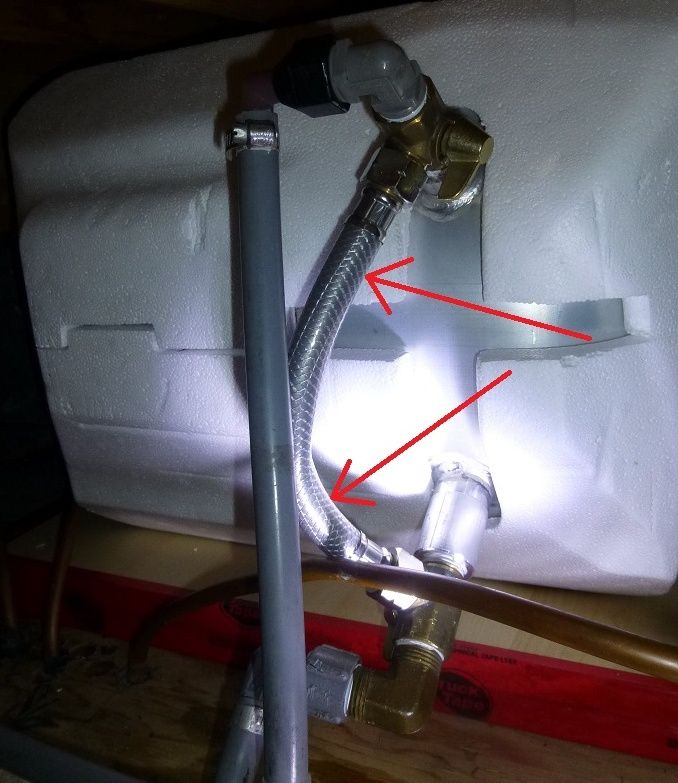Forum Discussion
- LarryJMExplorer II
dahlia55 wrote:
We were also wondering if that is PEX or PVC. Assuming it is PVC as the line is marked, "180*F / 100 PSI"
As other have said that clear reinforced vinyl line is for your bypass now a little info on line colors:
1. That Grey line is most likely Poly-Butyl which was used from the 1970s till 90s and was basically outlawed because it would get brittle and leak due to the chlorine and especially in hot water. I personally would replace it or be very, very cautious and NEVER leave you water lines pressurized even on city water if you are not physically in the trailer. It is a disaster just waiting to happen and it is also prone to cracking and leaking especially at fittings just from the movement in TTs.
2. PVC is not rated for hot, only cold water and is usually white in color.
3. Before PEX which can be any color, but is easily identified by the metal bands used in the fittings. You could run into PEX with Shark Bite or Quest fittings, but they would not come from the factory with those. The alternative was CVPC which is generally cream in color and is rated for both hot and cold water. CVPC is sort of out of vogue and harder to find with PEX being the most common water line used today.
Before someone finds what can surely be exceptions to the colors I mentioned above what I posted is what I consider a very good first cut on identifying the type of lines.
Larry - doxiemom11Explorer IILeave it there. In 2 years, we have already had a leak from a connection on the water heater and was able to use the bypass so we still had cold water to use until DH could get parts he needed to repair the leak. That was very helpful to me trying to prepare meals. It did take a couple of days to find parts we needed because of the remoteness of our location as camp hosts.
- wa8yxmExplorer IIIThe water heater bypass is used as follows.
3 ways to winterize, Method 1 (Wet)
Drain the water heater (Outside, remove the plug in the bottom and open the TPR valve at the top manually to drain it) while you are at it flush the thing out (Flush out any solids in the tank) if it's a surburan inspect the anode (Attached to the plug). If it's an attwood, Skip that it does not use one.
Operate the bypass valve so that no water enters the water heater and then pump Pink Stuff (RV antifreeze) into all the lines, forcing the water out.
Come spring you got to flush all that******out of there.
Method 2
Dry method.. I operate the bypass, then blow out the lines, drain the water heater as above.. HOWEVER it is not necessary to operate the bypass. You can drain the water heater, Blow the lines, drain the water heater, blow the lines,
You need to do this about 10 times to be safe.
(Even if you use the bypass you blow out the lines)
TO blow out the lines open all valves and feed the city water connection compressed are regulated to around 50-55 PSI.
NOTE: in this method you do not need the bypass.
Method 3: South, Carolina in my case (Upstate SC, below 1,000 feet elevation, temps get down into the 20's over winter but since the rig is occupied and heated not a problem) - haddy1ExplorerThe grey pipe is probably not PEX. I can't remember what it is, but it's not used any more because of numerous problems. BTW, I wouldn't rely on the screw type clamp on the top fitting. It can't provide enough force to prevent a leak.
- skipncharExplorerWithout the by-pass line you will not be able to properly winterize your RV using antifreeze. You will have ZERO water to the hot water lines without the bypass line. If you winterize before closing off the water heater then you will need to use an extra amount of antifreeze to fill the water heater before winterizing the hot lines. If you remove the lines you will STILL have two fittings and THEY can leak (much more likely to leak than the PEX tubing is). I'd leave it alone and use it as designed but it's your call.
Good luck / Skip - LockyExplorerYES, leave it on as others have said and also you need to turn your valves on or you won't be getting any hot water.
- CloudDriverExplorerAfter draining the water heater when winterizing, put the drain plug back in. Keeps the insects out of the tank and hot water piping.
- dahlia55ExplorerOk. I will leave it on. Thanks for the awesome replies.
- Bob_OlallawaExplorerYou do need to leave that bypass and valves on the water lines to the tank. That is the way you get antifreeze into the hot water lines without filling the tank too.
- Fire_InstructorExplorerRemoving it would be a mistake, as it's a bypass that allows proper winterization, and is an "emergency" by-pass, incase the water heater fails. You can still use your water system, even if the heater springs a leak or dies.... Even while it's removed and being repaired or replaced.
About Technical Issues
Having RV issues? Connect with others who have been in your shoes.24,201 PostsLatest Activity: Feb 19, 2025
